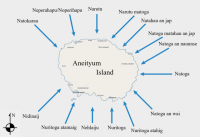This page has returned 100 entries
napat
n. a cloud, blackness, darkness
bookmarknap̃at

nap̃at

n. terrestrial fern, growing in dwarf cloud-forest. (collection: Gregory M. Plunkett #3268)
Example: For performing a weather magic ritual to produce fog, this plant is fermented along with another plant (nirid u numu) in a hole in a sacred stone (called "Naemoso") at a secret location on Aneityum.
bookmarknapau
n. kind of tree
bookmarknapau emilmat
n. kind of taro
bookmarknapauwa
n. kind of taro
bookmarknapauwahpa
n. kind of taro
bookmarknapayu
n. kind of tree
bookmarknapdaj

napijelcau
n. kind of banana
bookmarknapile
n. kind of taro
bookmarknapisinijvaig
n. kind of sugarcane
bookmarknapjau

n. grass. Found along intra village path. (collection: Ashley A McGuigan #35)
Example: 1. Bath for babies to make them healthy and walk faster, mix with plants WAKAS (AAB 34), NITIDEI (GMP 3658 or 4043), and a grass NATUTAHUT (MJB 4945). Put all in a kettle filled of water and wash them with it – use 1 handful of each leaf.
bookmarknapjis
n. a species of grass
bookmarknapleaig
n. kind of tree
bookmarknapleañ

napod
n. kind of tree
bookmarknapod
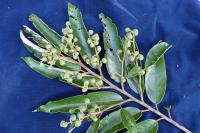
n. tree to 10 m, dbh 30 cm (collection: Michael J. Balick #4900)
Example: Before there was soap, people took the young leaves and crushed them on a stone to make suds for washing clothes in the river. This tree has a very hard wood and can be used for house posts. The sap is reddish and the bark boiled in water until it is red, consumed 2-3 times daily (1 cup each time) until the person feels well. The condition treated is that when a menstruating woman has sex with a man, and he feels tired and lethargic, drinking this tonic makes him feel stronger.
bookmarknap̃od

napoijec
n. kind of tree
bookmarknapojev

n. sparsely branched tree, growing in open (collection: Gregory M. Plunkett #3477)
Example: The leaves of this plant are used in cooking, particuarly with the earth oven. Use a fire to heat stones, then when the fire burns down and the stones are hot, pile these leaves on top of the hot stones and then place the food being cooked--taro, fish, pig, cassava, banana or other foods--on top of the leaves. Then pile more of these leaves on top of the food and then place additional hot stones on top of that pile of leaves. While the food is cooking--each type of food takes a different amount of time--the leaves give off a very nice smell and help flavor the food.
bookmarknapojev

n. sparsely branched tree, 5 m tall (collection: Gregory M. Plunkett #3493)
Example: The leaves of this plant are used in cooking, particuarly with the earth oven. Use a fire to heat stones, then when the fire burns down and the stones are hot, pile these leaves on top of the hot stones and then place the food being cooked--taro, fish, pig, cassava, banana or other foods--on top of the leaves. Then pile more of these leaves on top of the food and then place additional hot stones on top of that pile of leaves. While the food is cooking--each type of food takes a different amount of time--the leaves give off a very nice smell and help flavor the food.
bookmarknap̃ojev

n. well branched tree, 14 m tall (collection: Gregory M. Plunkett #3651)
Example: Poles made from this plant are used for house rafters and burned for firewood. To plant taro in a swampy area, collect the leaves of this species and put them in the hole where the taro is to be planted, mix with a bit of soil and then plant the taro on top of that. Leaves are a type of fertilizer. Used when baking with the earth oven. Hot stones cover the food and then the leaves from this plant cover the stones. The leaves stay on the branch.
bookmarknapojev

n. tree to 5 m, dbh 10 cm (collection: Michael J. Balick #4889)
Example: The leaves are used to cover meat when baking it in a stone oven (inmawum). This will soften the meat and keep it moist. Used when other species of this genus are not available, for example if you are in the bush.
bookmarknap̃ojev
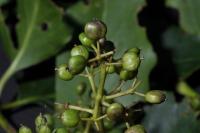
naporkos
n. kind of taro
bookmarknaposjilcau
n. kind of tree
bookmarknapua
n. kind of taro
bookmarknapudve
n. kind of plant, grass, or fern
bookmarknap̃udve
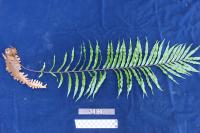
n. epiphytic fern, fallen to ground (collection: Gregory M. Plunkett #3494)
Example: When a dog is poisoned by cuguatera from eating a fish, the root of this species is collected, cleaned and a handful is boiled in 1-2 cups of water and given to the dog to drink. This treatment should be done 3x daily, in the morning, around noon and during the evening meal for as long as the dog is sick.
bookmarknapuig
n. a reed frame for supporting the tendrils of yams
bookmarknapujatha

napuke
n. a mound or hillock for yams
bookmarknapuleman
n. kind of banana
bookmarknapun nitai caig
n. the skin or rind of food
bookmarknapupwi
n. kind of sugarcane
bookmarknapupwi a darumea
n. kind of sugarcane
bookmarknara
n. kind of tree
bookmarknarahcai
n. a table made of reeds, for drying arrowroot, etc.
bookmarknaraki
n. a calm, a smooth sea
bookmarknarakiraki
n. a whirlwind
bookmarknaran
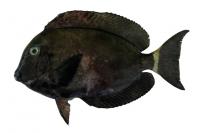
n. Orange-socket surgeonfish
Example: Photo by ANFC, License: CC BY-SA 3.0 via Fishes of Australia
bookmarknarasincai
n. bark
bookmarknarasinipjin necsei nupu afrika

narasitai
n. chaff
bookmarknaravi
n. a gathering of inmops or horse-chestnuts
bookmarknarayag

n. tree. Growing in village garden. (collection: Ashley A McGuigan #20)
Example: 1. To cure toothache when pregnant - Take the inner bark from Intejed and boil it in a pot of seawater (about 1 liter) along with 2 leaves from each of inpounatmas, narayag, nahayag, and nelmaha. Boil until juice is visibly leaving the plants. Put this water into your mouth and hold it there for 2-3 minutes. Do this this with one cup in the morning, 1 cup in the afternoon, and 1 cup in the evening. 2. Plant used to check with fish has ciguatera, in same way as other collection – GMP #4768. Stick white – OK to eat. Stick black or brown – not good.
bookmarknarecheno
n. kind of plant, grass, or fern
bookmarknared
n. current in the sea
bookmarknared

n. vine climbing on trees, growing in dense rainforest. (collection: Gregory M. Plunkett #4090)
Example: 1. The rachis of an old plant is braided as a rope to tie sugar cane, house posts, and fences. The rachis is used when green, and as it dries in form, it remains functional and lasts for a long time (10-12 years).
bookmarknared

n. vine to 3 m, sori brown. (collection: Michael J. Balick #4930)
Example: Take a handful of the vine, twist it into rope with many stems of the vine, and use it to tie bundles of sugar cane. It can also be used to tie wild canes (Miscanthus) to the roof of the house. Take a handful of the vine, twist it into rope with many stems of the vine, and use it to tie bundles of sugar cane. It can also be used to tie wild canes (Miscanthus) to the roof of the house.
bookmarknareram
n. kind of banana
bookmarknareuc henau
n. a species of grass
bookmarknarevaro

naridjai o un
n. east
bookmarknarijo

narijo

n. epiphytic fern on decaying log, growing in dense rainforest. (collection: Gregory M. Plunkett #4088)
Example: 1. Considered the same as Narijo. When it grow in good soil it takes the form of GMP 4087. In cold and rocky soil it this form.
bookmarknariko
n. bean
bookmarknariko
n. lentils
bookmarknariko

n. shrub to 3 m, flowers yellow with red outer coverings (appearing red when closed) (collection: Michael J. Balick #4957)
Example: This plant is used to fertilize fields, especially by growing it in fields that have been used for other crops for a very long time. The seeds can be cooked when dry and hard, boiled in water, or eaten directly without preparation when green and soft.
bookmarknariko cei

n. fence-forming shrub, 1. 5 m tall (collection: Gregory M. Plunkett #3206)
Example: 1a. Cultivated in gardens. Cook seeds of this species or eat them raw before they are fully ripened. The green pods can also be cooked in a fire and eaten. 1b. Cultivated plant for its edible seeds, can be prepared in a pot of bamboo. OR could take branches w/ seeds and put directly on the earth oven for cooking. 2. Planting this species adds nitrogen to the soil--grow it on soil that is said to be "tired."
bookmarknarineom
n. hedge
bookmarknariramteh
n. kind of banana
bookmarknarpomyiv

narutu arari
n. wind-related term; no definition provided
bookmarknarutu matua
n. wind-related term; no definition provided
bookmarknarutu umlai
n. wind-related term; no definition provided
bookmarknasahas
n. a small water-plant
bookmarknasancai
n. a tree full of sap
bookmarknasanhac
n. the poison of the inhac
bookmarknasanma
n. the juice of the breadfruit tree
bookmarknasau
n. a crop; fruit which grows spontaneously
bookmarknasiaij
n. a native plant, the leaves of which are used as cabbage
bookmark


